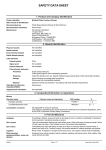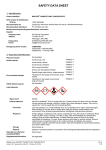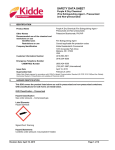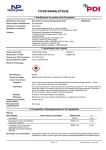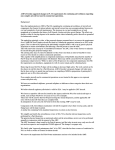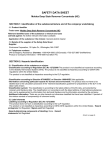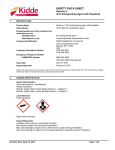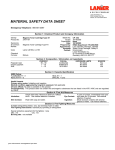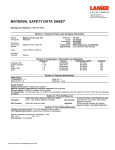Download Moldex 7010 Use and Care Manual
Transcript
SAFETY DATA SHEET 1. Product and Company Identification Product identifier Other means of identification Moldex Instant Mold and Mildew Stain Remover Not available Recommended use Stain remover Recommended restrictions None known. Manufacturer EnviroCare Corporation 10 Upton Drive Wilmington, MA 01887 US Phone 1-978-658-0123 Emergency Phone - CHEMTREC (US/Canada): 1-800-424-9300 (Intl/Maritime): +1-703-527-3887 2. Hazards Identification Physical hazards Not classified. Health hazards Not classified. Environmental hazards Not classified. OSHA defined hazards Not classified. Label elements Hazard symbol None. Signal word None. Hazard statement The mixture does not meet the criteria for classification. Precautionary statement Prevention Observe good industrial hygiene practices. Response If swallowed: Rinse mouth. Do NOT induce vomiting. Storage Store away from incompatible materials. Disposal Dispose of waste and residues in accordance with local authority requirements. Hazard(s) not otherwise classified (HNOC) None known. Supplemental information This product is not subject to 29 CFR HCS 1910.1200 regulations. The following HCS exemption for consumer products applies; 29 CFR 1910.1200(b)(6)(ix). 3. Composition/Information on Ingredients Mixture Chemical name CAS number % Sodium hypochlorite 7681-52-9 3-7 N,N-dimethyl-1-tetradecanamine, N-oxide 3332-27-2 0.1 - 1 Sodium metasilicate 6834-92-0 0.1 - 1 Composition comments Common name and synonyms This product is regulated by the CCCR (Consumer Chemicals and Containers Regulations, 2001) & the CPSC (Consumer Product Safety Commission). The exact % concentration of composition has been withheld as a trade secret in accordance with paragraph (i) of the OSHA HCS 1910.1200. 4. First Aid Measures Inhalation If symptoms develop move victim to fresh air. If symptoms persist, obtain medical attention. Skin contact Immediately flush with cool water for 15 minutes while removing contaminated clothing and shoes. Discard or wash well before reuse. Obtain medical advice immediately. Immediately flush with cool water. Remove contact lenses, if applicable, and continue flushing for 15 minutes. Obtain medical attention immediately. If vomiting occurs naturally, have victim lean forward to reduce risk of aspiration. Never give anything by mouth if victim is unconscious, or is convulsing. Obtain medical attention. Eye contact Ingestion #25706 Page: 1 of 8 Issue date 10-March-2015 Most important symptoms/effects, acute and delayed Causes serious eye irritation. Symptoms may include stinging, tearing, redness, swelling of the eyes, and blurred vision. Indication of immediate medical attention and special treatment needed Treat symptomatically. General information If you feel unwell, seek medical advice (show the label where possible). Show this safety data sheet to the doctor in attendance. Avoid contact with eyes and skin. Wear rubber gloves and chemical splash goggles. Keep out of reach of children. 5. Fire Fighting Measures Suitable extinguishing media Water. Carbon dioxide. Dry chemical. Foam. Unsuitable extinguishing media Not available. Specific hazards arising from the chemical Firefighters should wear a self-contained breathing apparatus. Special protective equipment and precautions for firefighters Firefighters should wear full protective clothing including self contained breathing apparatus. Fire-fighting equipment/instructions Move containers from fire area if you can do so without risk. Specific methods Use standard firefighting procedures and consider the hazards of other involved materials. General fire hazards No unusual fire or explosion hazards noted. Hazardous combustion products May include and are not limited to: Oxides of carbon. Oxides of nitrogen. Oxides of sodium. Chlorine. Explosion data Sensitivity to mechanical impact Not available. Sensitivity to static discharge Not available. 6. Accidental Release Measures Personal precautions, protective equipment and emergency procedures Keep unnecessary personnel away. Keep out of low areas. Keep people away from and upwind of spill/leak. Do not touch damaged containers or spilled material unless wearing appropriate protective clothing. For personal protection, see section 8 of the SDS. Methods and materials for containment and cleaning up Stop the flow of material, if this is without risk. Large Spills: Dike the spilled material, where this is possible. Cover with plastic sheet to prevent spreading. Absorb in vermiculite, dry sand or earth and place into containers. Prevent entry into waterways, sewer, basements or confined areas. Following product recovery, flush area with water . Small Spills: Wipe up with absorbent material (e.g. cloth, fleece). Clean surface thoroughly to remove residual contamination. Environmental precautions Never return spills to original containers for re-use. For waste disposal, see section 13 of the SDS. Avoid discharge into drains, water courses or onto the ground. 7. Precautions for safe handling Conditions for safe storage, including any incompatibilities #25706 Handling and Storage Use only with adequate ventilation. Avoid breathing vapors or mists of this product. Avoid prolonged exposure. Wash thoroughly after handling. Do not get in eyes, on skin or on clothing. Use good industrial hygiene practices in handling this material. Keep container tightly closed. Use according to package label instructions. Use only as directed on the container label. Store in a closed container away from incompatible materials. Store away from incompatible materials (see Section 10 of the SDS). Page: 2 of 8 Issue date 10-March-2015 8. Exposure Controls/Personal Protection Occupational exposure limits US. AIHA Workplace Environmental Exposure Level (WEEL) Guides Components Type Sodium hypochlorite (CAS 7681-52-9) STEL Value 2 mg/m3 Biological limit values No biological exposure limits noted for the ingredient(s). Exposure guidelines Chemicals listed in section 3 that are not listed here do not have established limit values for ACGIH or OSHA PEL. Ensure adequate ventilation. Appropriate engineering controls Individual protection measures, such as personal protective equipment Safety glasses recommended. Follow label directions carefully. Eye/face protection Skin protection Hand protection Rubber gloves recommended but not required. Follow label directions carefully. Other Follow label directions carefully. Respiratory protection Not normally required if good ventilation is maintained. Follow label instructions. Thermal hazards Not available. General hygiene considerations Wash hands before breaks and immediately after handling the product. Use good industrial hygiene practices in handling this material. When using do not eat or drink. 9. Physical and Chemical Properties Appearance Clear Physical state Liquid. Form Liquid. Color Pale yellow Odor Fresh, Slight chlorine. Odor threshold Not available. pH 11 - 12 Melting point/freezing point Not available. Initial boiling point and boiling range Not available. Pour point Not available. Specific gravity 1.05 - 1.10 Partition coefficient (n-octanol/water) Not available. Flash point Not available. Evaporation rate Not available. Flammability (solid, gas) Not applicable. Upper/lower flammability or explosive limits Flammability limit - lower (%) Not available. Flammability limit - upper (%) Not available. Explosive limit - lower (%) Not available. Explosive limit - upper (%) Not available. Vapor pressure Not available. Vapor density Not available. Relative density Not available. Solubility(ies) Not available. Auto-ignition temperature Not available. Decomposition temperature Not available. Viscosity 40 - 60 Cp VOC 0 g/L #25706 Page: 3 of 8 Issue date 10-March-2015 10. Stability and Reactivity Reactivity Possibility of hazardous reactions Reacts violently with acids. May react with incompatible materials. Hazardous polymerization does not occur. Chemical stability Stable under recommended storage conditions. Conditions to avoid Incompatible materials Do not mix with other chemicals. Contact with incompatible materials. Oxidizing agents. Acids. Hazardous decomposition products May include and are not limited to: Hydrogen chloride. Chlorine. Oxides of nitrogen. Sodium oxides. Oxides of carbon. 11. Toxicological Information Routes of exposure Eye, Skin contact, Inhalation, Ingestion. Information on likely routes of exposure Ingestion Health injuries are not known or expected under normal use. Inhalation Health injuries are not known or expected under normal use. May cause irritation to the respiratory system. Skin contact Causes skin irritation. Eye contact Causes irritation. Symptoms related to the physical, chemical and toxicological characteristics Direct contact with eyes may cause temporary irritation. Information on toxicological effects Acute toxicity Components Test Results Species N,N-dimethyl-1-tetradecanamine, N-oxide (CAS 3332-27-2) Acute Dermal LD50 Not available Inhalation LC50 Not available Oral LD50 Not available Sodium hypochlorite (CAS 7681-52-9) Acute Dermal LD50 Rabbit 10000 mg/kg Inhalation LC50 Rat > 5250 mg/m3 Oral LD50 Mouse 5800 mg/kg Rat 8200 mg/kg Sodium metasilicate (CAS 6834-92-0) Acute Dermal LD50 Not available Inhalation LC50 Not available Oral LD50 Mouse 2400 mg/kg Rat 1153 mg/kg Skin corrosion/irritation Prolonged skin contact may cause temporary irritation. Exposure minutes Not available. Erythema value Not available. #25706 Page: 4 of 8 Issue date 10-March-2015 Not available. Oedema value Causes irritation. Serious eye damage/eye irritation Corneal opacity value Not available. Iris lesion value Not available. Conjunctival reddening value Not available. Conjunctival oedema value Not available. Recover days Not available. Respiratory or skin sensitization Respiratory sensitization Not available. Skin sensitization This product is not expected to cause skin sensitization. Germ cell mutagenicity Mutagenicity Carcinogenicity No data available to indicate product or any components present at greater than 0.1% are mutagenic or genotoxic. No data available to indicate product or any components present at greater than 0.1% are mutagenic or genotoxic. The finished product is not expected to have chronic health effects. IARC Monographs. Overall Evaluation of Carcinogenicity Sodium hypochlorite (CAS 7681-52-9) Volume 52 - 3 Not classifiable as to carcinogenicity to humans. This product is not expected to cause reproductive or developmental effects. Reproductive toxicity Non-hazardous by WHMIS/OSHA criteria. Teratogenicity Specific target organ toxicity single exposure Not classified. Specific target organ toxicity repeated exposure Not classified. Aspiration hazard Not classified. Chronic effects Not classified. Further information This product has no known adverse effect on human health. Name of Toxicologically Synergistic Products Not available. 12. Ecological Information Ecotoxicity See below Components Species Test Results Sodium hypochlorite (CAS 7681-52-9) Crustacea EC50 Daphnia 2.1 mg/L, 48 Hours Chinook salmon (Oncorhynchus tshawytscha) 0.038 - 0.065 mg/l, 96 hours 0.28 - 0.57 mg/l, 48 hours Aquatic Fish LC50 Sodium metasilicate (CAS 6834-92-0) Aquatic Crustacea EC50 Water flea (Ceriodaphnia dubia) Fish LC50 Western mosquitofish (Gambusia affinis) 1800 mg/l, 96 hours Persistence and degradability No data is available on the degradability of this product. Bioaccumulative potential No data available. Mobility in soil No data available. Mobility in general Not available. Other adverse effects No other adverse environmental effects (e.g. ozone depletion, photochemical ozone creation potential, endocrine disruption, global warming potential) are expected from this component. 13. Disposal Considerations Disposal instructions Dispose of contents/container in accordance with local/regional/national/international regulations. Local disposal regulations See above Hazardous waste code Not established. Waste from residues / unused products This material and its packaging must be disposed of in a safe manner (see: Disposal instructions). #25706 Page: 5 of 8 Issue date 10-March-2015 Contaminated packaging Since emptied containers may retain product residue, follow label warnings even after container is emptied. 14. Transport Information U.S. Department of Transportation (DOT) Basic shipping requirements: UN number UN3082 Environmentally hazardous substances, liquid, n.o.s. (Sodium hypochlorite) Proper shipping name Hazard class Limited Quantity - US Packing group III Special provisions 8, 146, 335, IB3, T4, TP1, TP29 Packaging exceptions <5L Limited Quantity Transportation of Dangerous Goods (TDG - Canada) Basic shipping requirements: UN number UN3082 Proper shipping name ENVIRONMENTALLY HAZARDOUS SUBSTANCE, LIQUID, N.O.S. (Sodium hypochlorite) Hazard class Limited Quantity - Canada III Packing group Special provisions 16 Packaging exceptions <5L Limited Quantity DOT; TDG 15. Regulatory Information Canadian federal regulations This product has been classified in accordance with the hazard criteria of the Controlled Products Regulations and the SDS contains all the information required by the Controlled Products Regulations. Canada WHMIS Ingredient Disclosure: Threshold limits Sodium hypochlorite (CAS 7681-52-9) Sodium metasilicate (CAS 6834-92-0) WHMIS status 1% 1% WHMIS classification Exempt Exempt - Consumer product US federal regulations Consumer product TSCA Section 12(b) Export Notification (40 CFR 707, Subpt. D) Not regulated. US CWA Section 311 Hazardous Substances: Listed substance Sodium hypochlorite (CAS 7681-52-9) CERCLA Hazardous Substance List (40 CFR 302.4) Listed. Sodium hypochlorite (CAS 7681-52-9) Listed. Clean Air Act (CAA) Section 112(r) Accidental Release Prevention (40 CFR 68.130) Not regulated. Clean Air Act (CAA) Section 112 Hazardous Air Pollutants (HAPs) List Not regulated. Superfund Amendments and Reauthorization Act of 1986 (SARA) Immediate Hazard - Yes Hazard categories Delayed Hazard - No Fire Hazard - No Pressure Hazard - No Reactivity Hazard - No No SARA 302 Extremely hazardous substance No SARA 311/312 Hazardous chemical #25706 Page: 6 of 8 Issue date 10-March-2015 SARA 313 (TRI reporting) Not regulated. Other federal regulations Safe Drinking Water Act (SDWA) Food and Drug Administration (FDA) US state regulations Not regulated. Not regulated. This product does not contain a chemical known to the State of California to cause cancer, birth defects or other reproductive harm. US - California Hazardous Substances (Director's): Listed substance Sodium hypochlorite (CAS 7681-52-9) Listed. US - California Proposition 65 - Carcinogens & Reproductive Toxicity (CRT): Listed substance Not listed. US - Illinois Chemical Safety Act: Listed substance Sodium hypochlorite (CAS 7681-52-9) US - Louisiana Spill Reporting: Listed substance Listed. Sodium hypochlorite (CAS 7681-52-9) US - Minnesota Haz Subs: Listed substance Listed. Sodium hypochlorite (CAS 7681-52-9) Listed. US - New Jersey RTK - Substances: Listed substance Sodium hypochlorite (CAS 7681-52-9) Listed. US - New York Release Reporting: Hazardous Substances: Listed substance Sodium hypochlorite (CAS 7681-52-9) Listed. US - Texas Effects Screening Levels: Listed substance Sodium hypochlorite (CAS 7681-52-9) Sodium metasilicate (CAS 6834-92-0) US. Massachusetts RTK - Substance List Listed. Listed. Sodium hypochlorite (CAS 7681-52-9) US. Pennsylvania RTK - Hazardous Substances Listed. Sodium hypochlorite (CAS 7681-52-9) US. Rhode Island RTK Listed. Sodium hypochlorite (CAS 7681-52-9) Listed. Inventory status Country(s) or region Canada Inventory name Domestic Substances List (DSL) On inventory (yes/no)* Yes Canada Non-Domestic Substances List (NDSL) United States & Puerto Rico Toxic Substances Control Act (TSCA) Inventory No Yes *A "Yes" indicates that all components of this product comply with the inventory requirements administered by the governing country(s) 16. Other Information LEGEND HEALTH / 1 0 Severe Serious Moderate Slight Minimal 4 3 2 1 0 FLAMMABILITY 0 PHYSICAL HAZARD 0 PERSONAL PROTECTION X 1 0 Issue date The information in the sheet was written based on the best knowledge and experience currently available. Information contained herein was obtained from sources considered technically accurate and reliable. While every effort has been made to ensure full disclosure of product hazards, in some cases data is not available and is so stated. Since conditions of actual product use are beyond control of the supplier, it is assumed that users of this material have been fully trained according to the requirements of all applicable legislation and regulatory instruments. No warranty, expressed or implied, is made and supplier will not be liable for any losses, injuries or consequential damages which may result from the use of or reliance on any information contained in this document. 10-March-2015 Effective date 01-March-2015 Expiry date 01-March-2018 Further information For an updated SDS, please contact the supplier/manufacturer listed on the first page of the document. Disclaimer #25706 Page: 7 of 8 Issue date 10-March-2015 Prepared by Dell Tech Laboratories, Ltd. Phone: (519) 858-5021 Other information This Safety Data Sheet was prepared to comply with the current OSHA Hazard Communication Standard (HCS) adoption of the Globally Harmonized System of Classification and Labeling of Chemicals (GHS). This SDS conforms to the ANSI Z400.1/Z129.1-2010 Standard. #25706 Page: 8 of 8 Issue date 10-March-2015









